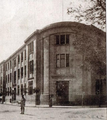Belgian concession of Tianjin
Belgian concession of Tianjin | |||||||||
|---|---|---|---|---|---|---|---|---|---|
| 1902–1931 | |||||||||
 Flag | |||||||||
 | |||||||||
| Status | Concession of Belgium | ||||||||
| History | |||||||||
• Established | 1902 | ||||||||
• Annexation | 1931 | ||||||||
| Area | |||||||||
• Total | 0.48562 km2 (0.18750 sq mi) | ||||||||
| |||||||||
| Today part of | People's Republic of China | ||||||||
The Belgian concession of Tianjin (Chinese: 天津比租界; pinyin: Tiānjīn bǐ zūjiè) was a 120 acre concession in the Chinese city of Tianjin occupied colonially by Belgium between 1902 and 1931, the only Belgian concession in China. However, there are no traces of any Belgian influence in Tianjin in the present day, as Belgium invested very little into its concession.
History[]
Despite not sending in troops to fight during the Boxer Rebellion, Belgium was able to claim the parcel of land east of the Hai River in negotiations under consul Maurice Joostens, even though Russia had claimed the land previously. After claiming that Belgium will build factories in the area, Russia relented.[1] On February 6, 1902, of the Qing government signed the Tianjin Belgian Concession Contract with , acting consul of Belgium in Tianjin. Soon after the concessions were demarcated, wooden stakes were nailed next to the Russian concession to delimit the Belgian concession.[1]
Its development was very limited due to multiple factors. The location of the concession was the furthest from the commercial centers of Tianjin; moreover, its geographical situation was the most limited out of all concessions. In fact, the Belgian consulate in Tianjin was located in the British concession due to the concession's remoteness.[2] Although the concession had good shipping conditions, the geographical advantage of water transportation over the Concession has not been fully exploited due to the remoteness and the little investment the Belgian government wanted to put into the concession. Thus, the income the concession brought to Belgium was very limited; the 80 thousand taels of silver spent on the only municipal project (a river road) came from debt. Only later did a British firm, the , lease 180 acres of land in the territory.[2]
With an impending financial crisis looming over the concession, the Belgian consul to China announced it will give back the concession to China as a gesture of friendship. On August 31, 1929, China and Belgium signed a charter for the return of the Tianjin-Belgium Concession, stipulating that the administrative power of the concession and all the public properties of the concession should be transferred to the Chinese government; on the other hand, the 93,000 taels in debt (with interest) shall be repaid by the Chinese government.[3] In March 1931, the handover ceremony was officially held, and the Tianjin Concession was changed to the Fourth District within the Tianjin Special Administrative Region.[2]
Legacy[]
Though very little was spent on the concession itself, the Belgians were much active in Tianjin, especially with establishing a monopoly over Tianjin's infrastructure over its trams, railways, and electricity. The Belgian-owned was vital in building Tianjin's early infrastructure: by 1914, the company's tram lines had covered most of Tianjin and four of its concessions, and as a result, Tianjin became the first Chinese city to have a modern public transportation system (Shanghai had to wait until 1908 to get electric tramways).[2] The supply of electricity and lighting and the trolley business were profitable ventures. By 1914, the network covered the Chinese city as well as the Austrian, French, Italian, Japanese and Russian concessions. The Belgians did so much work on Tianjin's infrastructure that they were called the "engineering team leader" of multiple concessions.[2]
The company was taken over by the Japanese army in 1943 and the members of the Belgian staff, often with their families, were sent to internment camps. Following the end of World War II, the Chinese authorities took over the network. The Brussels-based company tried to get compensation, but the Chinese Revolution in 1949 left them without any indemnity. Two more lines were built under Chinese administration, but the tram network was finally closed around 1972.[2]
Gallery[]

Belgian consulate in the British concession

Tianjin trams, owned by the Belgian Tientsin Tramway and Lighting Company

Main road of the Belgian Tianjin concession
List of consuls[]
Belgian consul-generals[]
- Henri Ketels (1902–1906)
- Albert Disière (1906–1914)
- Auguste Dauge (1914–1919)
- Ernest Franck (1919–1923)
- Alphonse van Cutsem (1923–1929)
- Tony Snyers (1929–1931)
See also[]
- Concessions in Tianjin
- Concessions of China
- Map of concessions in Tianjin (in Chinese)
- Belgian colonial empire
- List of former foreign enclaves in China
References[]
- Concessions in China
- Former Belgian colonies
- 20th century in Tianjin
- History of Tianjin
- Former colonies in Asia
- European colonisation in Asia


